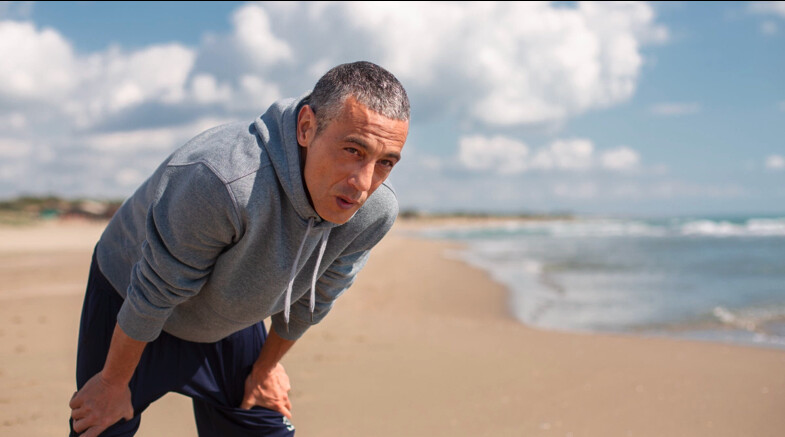Running News Daily
Running News Daily is edited by Bob Anderson in Mountain View, California USA and team in Thika Kenya, La Piedad Mexico, Bend Oregon, Chandler Arizona and Monforte da Beira Portugal. Send your news items to bob@mybestruns.com Advertising opportunities available. Over one million readers and growing. Train the Kenyan Way at KATA Running Retreat Kenya. (Kenyan Athletics Training Academy) in Thika Kenya. Opening in june 2024 KATA Running retreat Portugal. Learn more about Bob Anderson, MBR publisher and KATA director/owner, take a look at A Long Run the movie covering Bob's 50 race challenge.
Index to Daily Posts · Sign Up For Updates · Run The World Feed
The Surprising Way Air Hunger Limits Your Endurance
The fitter you get, the more likely you are to feel that you can’t get enough oxygen during hard exercise
Our lungs and airways are “overbuilt,” according to exercise physiologists. Though we gasp and pant during heavy exercise, that’s not what actually slows us down. Instead, the bottleneck is the heart’s ability to pump oxygen-rich blood to the muscles, or the muscles’ ability to make use of that oxygen. That’s why the heart and muscles get bigger and stronger in response to training, while the lungs stay the same: we already suck in more oxygen than we’re able to use.

Or maybe not, according to a new study in Medicine & Science in Sports & Exercise that takes a fresh look at what it means to be out of breath. It turns out there are different subtypes of breathlessness. Your chest might feel tight; or your breathing muscles might feel overworked; or you might feel that you can’t get enough air in. That last one, sometimes called “air hunger” or (more scientifically) “unsatisfied inspiration” is usually associated with lung conditions like chronic obstructive pulmonary disease. But the new study finds that about a third of healthy adults experience air hunger during all-out exercise—and it’s the fittest people who are most susceptible.
The study, led by researcher (and accomplished mountain runner) Jordan Guenette and graduate student Olivia Ferguson of the University of British Columbia, reanalyzed earlier results from lung-function tests completed by 321 healthy adults between the ages of 19 and 40 in labs at the University of British Columbia and McGill University in Canada. Among the tests was an incremental cycle to exhaustion, after which subjects were given a list of 15 phrases that described subjective sensations of breathlessness and asked to pick which ones applied to them.
Four of the phrases corresponded to air hunger: “I cannot get enough air in,” “I cannot take a deep breath in,” “My breath does not go in all the way,” and “I feel a need for more air.” Those who picked at least three of those four phrases were classified as having air hunger. Healthy adults usually associate breathlessness with the perception that their breathing muscles are working really hard, rather than with air hunger. But to the surprise of the research team, 34 percent of the subjects fell into the air hunger category.
Air hunger doesn’t necessarily mean that you’re truly short of oxygen—but it feels that way, which is enough to create problems. There are two distinct dimensions of breathlessness: the sensory experience (what it feels like) and the affective/emotional response (how you react to that feeling). Air hunger is a sensory experience, but it’s tightly linked to a negative emotional response. No one likes to feel that they can’t get enough air in. In patients with lung disease, the feeling of air hunger is a major deterrent to exercise even when it doesn’t directly compromise exercise capacity.
To figure out if the same thing happens in healthy adults, the subjects were also asked to rate the discomfort in their legs on a scale of zero to ten, do the same for breathing discomfort, and make as estimate of how much their decision to give up in the exercise test was due to leg and breathing discomfort, respectively. Sure enough, breathing discomfort was higher in the air hunger group, and about half of them said that it played a part in their decision to quit, compared to less than 30 percent in the non-air hunger group.
One sign that this breathing discomfort wasn’t all in their heads is that the air hunger group had stronger markers of “critical inspiratory constraints” (CIC)—that is, limitations on their ability to breathe more deeply. When your body detects that carbon dioxide levels in your blood are rising, it automatically triggers deeper breathing to flush out the carbon dioxide and get more oxygen in. But if you have CIC, you’re at a point where it’s hard to inflate your lungs any further, so there’s a mismatch between your desire to inhale and your ability to do so. Sure enough, the people in the air hunger group had several indicators of more severe CIC. For example, they had a smaller peak inspiratory capacity (the maximum volume of air they could inhale), and a smaller increase of inspiratory capacity during exercise.
The next question is what determines who suffers from air hunger and CIC. One difference between the groups is that those with air hunger had, on average, higher VO2 max by 1.5 percent, and reached a higher peak power output by 3.4 percent. They were also breathing faster at exhaustion (50 breaths per minute compared to 47) and sucking in more air (120 liters per minute compared to 116). “Contrary to popular belief,” Guenette points out, “exercise training doesn’t improve lung capacity.” So one version of the story is that fitter people can push themselves harder for longer, but their lungs aren’t equipped to handle the higher load, so they’re more likely to approach their breathing limits.
On the other hand, while the differences in VO2 max are statistically significant, they’re pretty subtle. Could there be other factors that dictate who suffers from the feeling of air hunger—something in the structure of the lungs or the strength of respiratory muscles? Is it a function of how the brain and central nervous systems respond to a given level of oxygen and carbon dioxide in the blood? None of this is clear yet, and neither is the crucial question of whether there’s anything you can do about it. There’s been a lot of research over the years about the idea of training your breathing muscles (including some by Guenette), and one of the theories is that any performance benefits are more about changing your subjective response to the feeling of breathlessness rather than actually delivering more oxygen to your muscles. That might be one way of combating the feeling air hunger; another possibility is the asthma medication salbutamol, which Guenette hopes to study further.
For now, what I take from this study is that I need to rethink one of my standard pieces of advice to beginner runners. Feeling out of breath is one of the dominant sensations when you first start running, but I’ve always assured people that it’s a feeling you get used to, and not something that really limits your performance. It turns that, for at least some people, that’s not true. My sense is that the recent hype about “better breathing” has far outpaced the evidence, but it’s clear that we still have a lot to learn.
(04/21/2024) Views: 133 ⚡AMPby Outside Online




